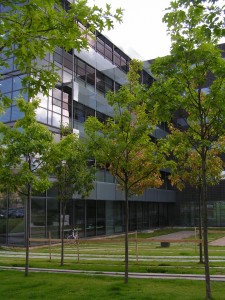An Open-Access, Standards-Supportive Publication that Rapidly Disseminates Concise Genome and Metagenome Reports in Compliance with MIGS/MIMS Standards: the Session Blog
Presenters: Oranmiyan W. Nelson
July 9, 2009 at 2:30 pm
Background
Dr. Nelson is currently completing his post-doctoral work at Michigan State University, in the Department of Microbiology & Molecular Genetics. He is also the production editor of Standards in Genomic Sciences (SIGS), an open-access e-journal of the Genomics Standards Consortium (GCS) established in September 2005.
Session Overview
Genomics and metagenomics describes the study of an organism’s complete genetic data set, with emphasis on sequence mapping. The former is limited to the study of organisms that can be isolated in pure culture, whereas the latter applies to an entire community of microbes in their native environment. Technological advancements have facilitated a data explosion; genomic maps are now being produced at a faster rate than the existing publication infrastructure can accommodate. The result is a loss of data, contextual metadata and annotation. Essentially valuable data is disappearing before it can be interpreted or see the light of publication.

Number of published journal articles per year relating to the complete genome sequences of bacteria and archea
SIGS is a GSC initiative to attempt to bridge this gap, by producing concise peer-reviewed reports that comply with MIGS/MIMS standards, in addition to operation procedures, commentary and review articles. Minimum Information about a (Meta)Genome Sequence (MIGS/MIMS) is a GCS initiative to expand on core reporting standards already established by the International Nucleotide Sequence Database Collaboration (INSDC). MIGS/MIMS is characterized by a standardized checklist that has been published in its entirety in Nature Biotechnology. SIGS will attempt to keep up with data production by offering an accelerated editorial revision workflow, where copy-editing begins almost immediately after initial acceptance.
The e-journal’s goal is to produce 600 publications by June 2011 (approximately 30 per month), by attracting internationally credible authors under a cost-effective model for an open-access journal.
A sample short genomic report was then described, in conjuction with MIGS/MIMS standards. The anatomy of a report included a abstract and introduction (a), genetic sequencing information (b) genome properties (c) and comparisons with previously sequenced genomes (d). Lastly, conclusions and references (e).
References
July 13, 2009 Comments Off on An Open-Access, Standards-Supportive Publication that Rapidly Disseminates Concise Genome and Metagenome Reports in Compliance with MIGS/MIMS Standards: the Session Blog
Copenhagen Business School Library offers OCS as Conference Management System to Their Faculty: the Session Blog
Presenters: Kirsten Suhr Jacobsen, Helle Damgaard Andersen, Peder Lærke Nielsen
July 9th, 2009 at 3:00 pm
Helle Andersen has managed the Copenhagen Business School‘s webservices since 1999, including the main CBS page and related services such as the open conference system (OCS). Kirsten Jacobsen has managed several international conferences hosted by CBS. Together with Peder Nielsen, the library IT department leader, CBS offers conference management system OCS as part of the schools public web system.
Session Overview
The CBS has approximately 15,000 students and 1,000 staff making it one of the largest institutions in Northern Europe. The school understands that conferences are a possible forum to attract investment, scholarship and students. In turn, a professional conference system, may attract an increasing number of conferences to Denmark.
To help this initiative, the university has allocated 3 years of funding for a conference Secretariat at CBS. A large number of conference management systems (CMS) were considered, and OCS was eventually chosen for being open-source, flexible, exclusively web-based and with a large available community to provide technical support.
OCS is a comprehensive package that addresses the many facets of conference management, from online submissions of relevant content to management of all people involved (from registrants to presenters and organizers). OCS even facilitates development of conference webservices and online discussion forums. In fact, the PKP Scholarly Publishing Conference 2009, was managed using OCS. The system’s main strengthes lies in its flexibility and detailed indexing capactiy, which allows for dealing with multiple conferences simultaneously. OCS 2.0 is originally based on open-source code developed for open journal systems, and the CBS group made several productive improvements through formatting modifications and software plug-ins.
Unfortunately, the CBS group has run into multiple difficulties overcoming template configuration problems (especially with navigation menus), and a large portion of time was spent discussing multiple suggestions for improvement to the core software. Majority of the CBS group’s concerns described issues surrounding formatting, style design, and the lack of descriptors from pull-down menus. Other issues raised included expansion of administrative modules, and further development of OCS documentation and tutorials. CBS has already started this process, and suggested that perhaps resources be pooled with the PKP support group and collaborative documents be published on wikipedia.
Peder Neilsen facetiously commented that it is a “Danish tradition of not talking about what is good, but what could be better.” Certainly the described OCS strengths lay not only in its cost (free), but also in the flexibility conferred by open-source code. Furthermore, OCS users may benefit from accessing not only the development team, but a support group comprising of an international community of fellow users. Certainly, this session highlighted the productive interplay between the open-source software developers (of whom Alec Smecher was present in the audience to represent) and the users. Continual feedback drives steady modifications to the original source-code, new plug-in creations and essentially product evolution.
July 13, 2009 Comments Off on Copenhagen Business School Library offers OCS as Conference Management System to Their Faculty: the Session Blog
Moving from Paper Production to Online Open Access with Open Journal Systems: The Session Blog
Presenter: Laura C. Botsford, Assistant to the Editor, Canadian Journal of Sociology, University of Alberta
Time: 4-5 pm, July 9th, 2009
Place: SFU Harbour Centre, Sauder Industries Room 2270
———————————————————————————————
Session Overview
Background
In the early days of the Canadian Journal of Sociology, a great deal of manual work was required to print the journal, from getting galleys to making notes in the margins, to cutting to appropriate size and pasting onto paper sheets, etc. The editors of the journal soon realized that they were susceptible to too many external factors and decided to move to typesetting and a mainframe computer. While this newer technology had its advantages, there were many codes to learn and all that could be seen was the markup language; not the end result. The lack of a preview often created surprises for the editors when the pages were printed. Eventually technology progressed and the journal got some computers with What You See Is What You Get (WYSIWYG) capabilities– but they still had to go through the whole printing process. Dr. Kevin D. Haggerty took over as editor in 2007 and within a few months, decided to go electronic and open access with the journal. While everyone involved had many questions and qualms, they ultimately ‘took the plunge.’
Related Information Re: Printing Processes
Click here for a printing press demonstration on Youtube
A more recent version of the printing press:
(source)
Using the Open Journal System (OJS)
Moving to electronic publishing has reduced many of the traditional problems involved with the printing process and OJS has features that are very helpful, such as its functionality for the second review– the system automatically generates a list of reviewers and filters out those who have already declined in the first review.
However, OJS still poses many problems for users, so patience and technical support is absolutely critical.
Session Questions
Comment: There are currently seventeen journals running on the University of Alberta website, but the Canadian Journal of Sociology has been the most conversive, and questions have really pushed the development of OJS forward.
Question: What was the driving force to move to online and open access? We were becoming aware of the new generation of scholars coming up, and they are expecting to see their info on the internet. Also, printing and mailing is becoming increasingly expensive.
Question: How many copies were being printed prior to moving to electronic form? Answer: 1000
Question: How has converting from print to open access impacted the finances of the journal? Answer: It was a subscription journal, but the journal has been anomalous. We had some money in the bank, and received money from aggregators who have continued to contribute. One of the reasons for moving to open access was that subscriptions were dwindling– libraries were declining because they were lacking space and funding.
Question: Any plans to digitize back files? Answer: Yes. We haven’t tried it yet, but are definitely planning to.
Question: What is your business model? How much does it really cost to run the journal? Revenue stream? etc. Answer: Revenue stream usually from the Social Sciences and Humanities Research Council of Canada (SSHRC) and aggregators, but we also had money in bank that was invested. We also benefit from non-monetary things that the university provides, such as office space, release time from teaching for Dr. Haggerty, etc.
References
Taking the plunge Haggerty, K.D. (2008). “Taking the plunge: open access at the Canadian Journal of Sociology” Information Research, 13(1) paper 338. [Available at http://InformationR.net/ir/13-1/paper338.html]
Related Links
July 13, 2009 Comments Off on Moving from Paper Production to Online Open Access with Open Journal Systems: The Session Blog
Providing an Incentive: Developing Publishing Services for Researchers: The Session Blog
Presenter: Sara Fuchs, Digital Initiatives Library, Department of Scholarly Communication & Digital Services, Georgia Institute of Technology
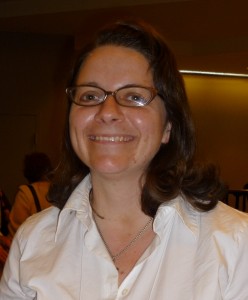
Sara Fuchs
Time: 4-5pm, July 9th, 2009
Place: SFU Harbour Centre, Sauder Industries Room 2270
———————————————————————————————
Session Overview
Background
The Georgia Tech Library Department of Scholarly Communication & Digital Services set up an institutional repository in 2004 in hopes that faculty members could self-submit. Although they had always had a repository, it was usually set up after conferences had occurred. The department later decided to provide more support and began to help faculty create, store and view their papers, especially since nobody else on campus was offering similar services. The service provides both conference and journal support, as well as the uploading of any video recordings (of lectures as well), and digital archiving on the centralized repository for Georgia Tech authored materials, known as SMARTech. Submission onto SMARTech requires that the authors grant a non-exclusive license to Georgia Tech for non-commercial uses– mainly to raise awareness about open access to graduate students and supporting scholarly collaboration. SMARTech is now one of the largest institutional repositories in the United States and 35th in the world according to the Ranking Web of World Repositories, a project by the Spanish public research body Consejo Superior de Investigaciones Científicas (CSIC).
Lessons Learned with Open Conference Systems (OCS)
OCS works well for what it is supposed to do. It was a low pressure situation for the department because there was no need to maintain the OCS software, as everything was eventually going to end up in the repository. They found that clients enjoyed using OCS much more than the normal email workflow.
However, there were still challenges. With OCS, the process of accepting and rejecting proposals was more difficult– conference calls seemed to be much easier, and there is always a time lag in uploading presentations. Another challenge surfaced while setting up the Open Repositories 2009 Conference, mainly because they were working with two different websites. It made it very difficult to collect and retrieve conference papers. The Access Services Conference was the first time the payment function of OCS was used. Again, it was difficult to synchronize across two websites and this required going through multiple steps.
Customization
Clients wanted something more slick and streamlined, and wanted to use the more interactive parts of OCS, such as giving comments directly to authors, etc. In order to do this, all .css and template files had to be modified. New headers needed to be created, as well as modification of some menus, journal layout, and downloading of specific plug-ins. This proved to be very time-consuming, and this took design changes out of the hands of journal managers/editors. That being said, clients were highly satisfied and this became a showpiece of the department’s collaboration with faculty.
Questions
(Ran out of time)
Comment: Some of the difficulty in syncing between two websites might be easier if you upload/download directly from OCS instead of another location.
Related Links
July 13, 2009 Comments Off on Providing an Incentive: Developing Publishing Services for Researchers: The Session Blog
Open Access Supports for Researchers in Canadian Universities: The Session Blog
July 9, 2:30 PM – Sauder Industries Room 2270
Presenters
Devon Greyson, Information Specialist with the UBC Centre for Health Services and Policy Research
Donald Taylor, Electronic Resources Librarian at Simon Fraser University
Background
The presentation provided an overview of a recently completed, quantitative study on the compliance of Canadian University libraries, as well as their concomitant research offices, with legislated funder mandates. Canadian research projects must provide open access versions of their findings as a condition of receiving financial support. The two presenters, Devon Greyson and Donald Taylor, outline the model used to determine relationships amongst all relevant parties, the guiding research questions, their methodology, the results and areas that require more investigation.
Session Overview
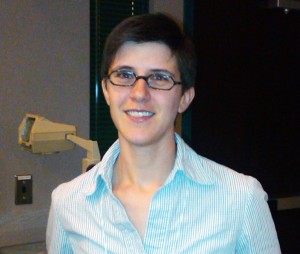
Devon Grayson at the PKP Conference (with permission)
Devon Greyson began the presentation by providing an overview of the study, which will be available through open access, on funding mandate compliance. Essentially this was a group project that created a common conceptual model of how research works in Canadian universities.
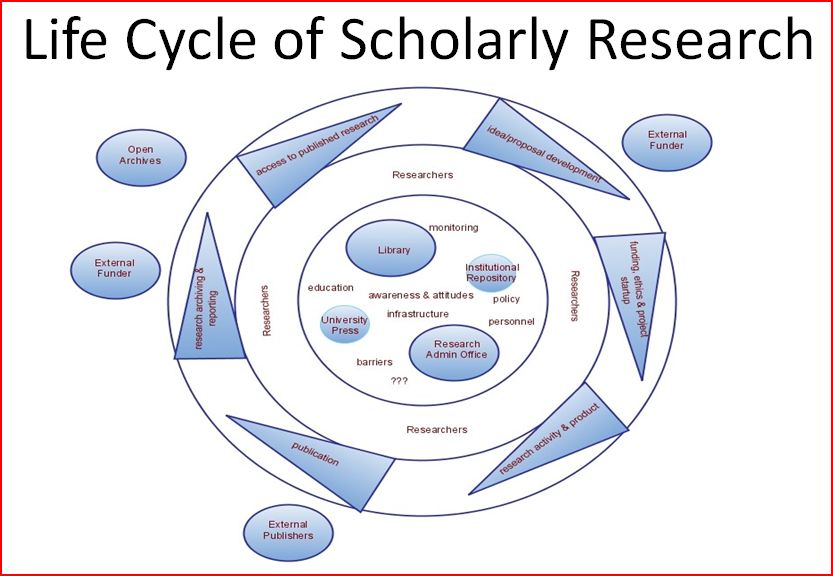 Scholarly Research Cycle (posted with permission of authors)
Scholarly Research Cycle (posted with permission of authors)
Open access has changed this research model, particularly because of Open Access Mandates instituted by Canadian research funders. The CIHR (Canadian Institute of Health Research) requires open access to peer reviewed articles within 6 months of publication, which places significant “impetus on the researcher” to publish results on line, or else funding will be curtailed. Similar policies in other Canadian organisations in the health sector, such as the Genome Project, are in place.
The Study’s Methodology
The study focussed on Canadian universities as a whole, which was represented by the libraries and research offices of each institution. The researchers used to following questions to guide their study:
(1) Are the various research agencies aware of open access funding mandates?
(2) Do they view the mandates as part of their purview?
(3) What is the extent of coordination between the libraries and research offices at each university?
Although there have been similar studies before, the survey questions used did not suit the Canadian context. Consequently new questions were drafted that applied to the research model above. The study concerned itself only with members of the Canadian Association of Research Libraries (CARL) and separate surveys were given to the respective libraries and research offices involved.
Donald Taylor pic
Overview of the Results

Donald Taylor at the PKP Conference (with permission)
Donald Taylor continued the presentation by reviewing the preliminary results. Surprisingly, only forty eight percent of research administration offices returned surveys, but sixty seven percent of libraries responded. Only thirty seven percent of the universities involved completed both surveys.
Sense of Mandate (posted with permission of authors)
Activity (posted with permission of authors)
Awareness (posted with permission of authors)
The three slides above illustrate that libraries are far more aware of the open access funder mandates than their counterparts. All of the libraries are aware of the mandates, compared to seventy eight percent of research offices. It is clear that libraries have a clearer understanding of their mandate to provide broad education on open access issues, whereas research offices recorded low numbers across the spectrum of questions. Furthermore, libraries were far more willing to engage in open access related activities or plan future endeavours than their research offices. Lastly, sixty percent of universities and research departments were aware of the other’s activity.
Conclusions
The results and responses tend to paint a picture of a lack of coordination and collaboration between two parties, with a few exceptions (some universities planned to include cooperation with other departments). It is also clear that there is an awareness lag between librarians and research administrators. It would seem that the two divisions have different views of their roles with regards to the mandates.
Follow-up Questions
(1) Is there overall compliance with mandates?
(2) Do authors want to participate in OA activities?
(3) How do we change the attitudes of researchers?
Analysis
This study illustrates that there is a distinct lack of understanding and cooperation on behalf of research offices to comply with legislated funding mandates, which explains Geist’s assertion that many universities are agonisingly slow to adopt open access initiatives (2007). These mandates have been instituted to ensure that researchers self archive their work and make it freely available in the associated institutional repository, which benefits the research community as a whole. It would seem that some research is being stalled as a result of a lack of compliance and that many journal publications resent having their economic domains infringed upon.
Related Links
Devon Greyson articles on Scientific Commons
Donald Taylor articles on Scientific Commons
Developments in Canadian Funding Mandates for OA
References
Geist, M. (2007). Push for open access to research . BBC News, Retrieved July 9, 2009, from http://news.bbc.co.uk/2/hi/technology/6404429.stm
July 13, 2009 Comments Off on Open Access Supports for Researchers in Canadian Universities: The Session Blog
Open Access CIM Journal Publishing: Editorial Essentials for Policies and Procedures: The Session Blog
July 9, 11:30 AM – Earl and Jennie Lohn Room 7000
Presenter
Glenn M. Hymel, Professor and former Chair of the Department of Psychology at Loyola University New Orleans
Background
This session covered the development of an online, open access, peer reviewed quarterly: The International Journal of Therapeutic Massage & Bodywork (IJTMB). The journal is intended to support practitioners in the field of complementary & integrative medicine (CIM).
Session Overview

Glenn Hymel (Source)
Professor Glenn Hymel began the session by outlining three objectives for his presentation: (1) to address recent developments and the progress to date of the IJTMB (2) to provide a journal editor’s perspective regarding policy decisions and procedural guidelines in the context of open access publishing (3) to provide a potential model that other independent journals could use. Subsequently, the professor described the journal as an open access, peer reviewed quarterly publication that reflects the Massage Therapy Foundation’s (MTF) mission to promote research, education as well as current best practice in the field of massage and bodywork. The MTF is a non-profit charity, but it does charge its members fees to cover operating costs.
Professor Hymel proceeded to discuss the scope of the IJTMB, which encompasses editorials, research, education, practice sections, commentaries, book reviews and announcements that are relevant to the massage profession. The journal’s board of trustees, comprising an e-Journal committee, an editorial board, an editor in chief and a manuscript review board, have final control of the budget, as well as its membership. The board had a number of key decisions to make during the formative stages of the journal, such as the software to use, the peer review process to follow and the stylistic requirements needed. Ultimately, the trustees agreed to use multi-Med (A Canadian Company) for publishing, a double blind review protocol that includes evaluation from a medical review board and style guidelines consistent CIM and allopathic journals. Lastly, the organisation chose to use creative commons licenses as their copyright policy.
Hymel concluded his presentation by discussing the issue of citation and accreditation. The journal uses the Google Analytics service to obtain quantitative input (web stats) that determines the IJTMB’s impact. The credibility derived from frequent web hits has been hampered by a lack of successful manuscript submissions, which demonstrates a need to make the review process more efficient, improved authorship guidelines, reader input through comment features and more extensive use of supplementary, multi-media files to augment entries. It was also suggested that the journal develop a plug-in “to enable continuing education activities related to journal articles”.
The professor answered a few questions at the end of the period. His responses reaffirmed the IJTMB’s intent to improve its effectiveness, as well as its immediacy by being quicker to release submitted articles between quarterly issues. Hymel hoped that this would increase availability. The professor also explained that that they have had to outsource contracting in order to reduce costs.
Analysis
The point of view of an independent online journal striving to serve its members and gain credibility as a reputable, authoritative resource is a profoundly recurring theme within the open access community. The challenge of balancing costs, yet maintaining a high quality journal is also significant. Furthermore, it is particularly interesting that professor Hymel advocates improved user friendly controls that promote interactivity and a more robust reading experience. The ability of members to possibly change or influence the original document and leave their comments potentially diminishes the reliability of such a publication, which is one of the established goals of the IJTMB. The tension between using the technology in a new and exciting ways, while maintaining traditionally defined authority, is problematic for all online journals. Can this paradox be resolved?
Related Links
The International Journal of Therapeutic Massage & Bodywork
July 13, 2009 Comments Off on Open Access CIM Journal Publishing: Editorial Essentials for Policies and Procedures: The Session Blog
On Library Publishing and the Open Humanities Press: A Panel Presentation by the UCLA Library and the University of Michigan Library’s Scholarly Publishing Office: The Session Blog
July 9, 9:30 AM – Fletcher Challenge Room 1900
Presenters:
Marta Brunner, Librarian for English and American Literature and Comparative Literature at the Charles E. Young Research Library at UCLA
Shana Kimball, Publications Manager in the Scholarly Publishing Office (SPO) at the University of Michigan Library
Archived Video Stream of Session
Background
This session provided the library perspective as a follow up to the previous discussion on the Open Humanities Press (OHP) and its involvement with digital monographs, or “liquid books” (Hall). UCLA is working in partnership with the Open Humanities Press to fulfil a number of open access ideals, while the University of Michigan Library is working specifically to produce and distribute many of the works housed by the OHP online.
Session Overview
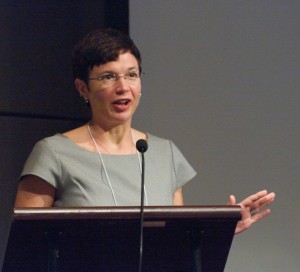
Marta Brunner at the PKP Conference (courtesy J. Miller)
Marta Brunner began the second half of the Open Humanities session by explaining her involvement with the online press. Originally she blogged the OHP and its endeavours prior to being contacted by one its founders, Sigi Jöttkandt, to be part of the body’s steering committee. Brunner has used her association with the OHP to bridge the dichotomous divide between research and library domains, which UCLA library has found to be an enormous asset.
“What future is UCLA library working to achieve?” Brunner asserted that this overarching question is the underlying motivation for the university’s work with the OHP. Furthermore, in light of the financial crisis and reduced budgets, open access issues are at a “watershed moment” where scholars and librarians will be working together to make more research freely available online. Brunner then outlined the library’s six fold vision, which ranges in order from most to least achievable:
1. UCLA seeks to be a flourishing hub of institutional repositories. While this is gaining ground many professors are still distrustful of online sources and perceive them to lack the same credibility as their print counterparts.
2. The library envisions itself as a curator of scholarly records. While this is considered a mandate for most university libraries, the “costs of migration” mean that “much content is overlooked” (Brunner).
3. UCLA hopes to disseminate an increasing amount of new digital media, which “enables semantically enhanced” (Brunner) products. The library has not been able to fulfil this goal on a large scale, but has created digital maps through the Hypercities project.
4. The library anticipates playing a greater role in providing open access content in classrooms. The UCLA library uses “a more liberal policy” (Brunner) towards content, which aligns neatly with the ideals of the OHP. One of the main benefits of this institutional leniency will be the increasing availability of cheaper text books spawned from more widely recognised open access scholarship.
5. The UCLA library hopes to be a paragon of a sustainable business model for housing and distributing open access content. Brunner used the comparison of the cost of a Toyota Corolla and the journal “Applied Polymer Science”: The periodical costs considerably more. Consequently, libraries will be facing economic crises as budgets are cut and journal costs stay high.
6. The most difficult goal to attain will be reducing to restrictive nature of academic tenure on open access scholarship. The generally perceived lack of authority of online sources continues to hinder the open access movement.
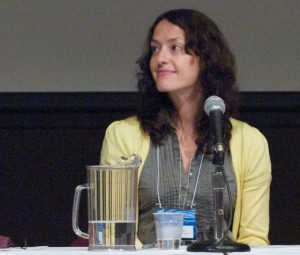
Shana Kimball at the PKP Conference (Courtesy J. Miller)
Shana Kimball began by posing a different question: “How do we scale a liquid book?” The University of Michigan Scholarly Publishing Office (SPO) seeks to provide an answer for this important query. Kimball outlined the role of the publishing branch of the library bOpen Humanities Press Panelefore explaining its core principles. The speaker then elaborated upon how these values guide the publisher’s work towards making research publications more cost effective, as well as elucidating on its partnership with the Open Humanities Press.
The University of Michigan publishing branch currently supports forty predominantly open access online journals, as well as a few print publications. The organisation also runs a “robust” reprint service for its online repositories and has published over 9000 titles on Amazon. Additionally, the SPO is working with the OHP to develop its online monograph (single subject books) endeavour as part of a pilot project whereby the university will “convert, host, provide access to, and archive” the series.
The University of Michigan Scholarly Publishing Office also operates with a set of six main beliefs to guide its aim of making scholarly publishing “more sustainable and scalable” (Kimball):
1. The SPO works at the peripheries of mainstream library services by providing copyright counsel in the copyright arena, cataloguing metadata, maintaining digital library functions and financing complicated transactions.
2. The SPO forms partnerships with other organisations to provide supplementary services, such as content sharing or publication conversions into digital forms amongst other enterprises.
3. The SPO believes strongly in protecting the rights of authors to use their own material as they see fit.
4. The SPO takes small, calculated risks that focus on perpetuating and promoting experimental texts, such as producing scholarly works within Comment Press that can be freely annotated.
5. The SPO provides a myriad of services that range from electronic publication to print on demand to content preservation.
6. The SPO is working cooperatively with the Open Humanities Press to extend its number of published series, as well as further enhance its reputation for high quality academic work. Authors will be able to choose to use a creative commons license while retaining copyright protection.
Ultimately, the SPO cannot attain the goal of supporting the OHP without creating partnerships with other bodies. Furthermore, the task of producing single monograph publications is a daunting one because the library / publisher relationship has been traditionally weak. Kimball concluded her presentation by welcoming interested parties to inquire about future collaborative endeavours and reaffirmed her organisation’s commitment to building the reputation of open access content, as well as being an agent of change in the advancement of the Open Humanities Press’ ideals.
Analysis
Both the UCLA Library and the University of Michigan Scholarly Publishing Office acknowledge to importance of the Open Humanities Press and seek to propagate its principles to the wider academic community. However, achieving change and gaining acknowledgment is proving to be difficult due to general academic distrust, high operational costs, a system of reputation based incentives that favour established scholars, as well as an overwhelming amount of content through which to sort. The goals of the OHP are laudable, but there needs to be an economic compromise between open dissemination of information at no cost to the consumer and providing profitable rewards to creators, researchers or artists in order to perpetuate the transmission of knowledge. The University of Michigan SPO appears to be negotiating this difficult dialectic by working with open access supporters, while charging for unique services and publishing traditional print journals, which is referred to as the mixed approach (Schmidt et al., 2005). The UCLA library, on the other hand, is focussing on reducing costs by embracing predominantly open access works. It will be interesting to see which institution offers the more sustainable business model and if other libraries will adopt these new paradigms. Moreover, it illustrates that the new open access ethos is having to coexist with traditional print resources until an alternative, yet effective, system of rewards can be established.
Related Links
University of Michigan Scholarly Publishing Office
References
Albert, K. M. (2006). Open access: implications for scholarly publishing and medical libraries. J Med Libr Assoc, 94 (3), Retrieved July 9, 2009, from http://www.pubmedcentral.nih.gov/picrender.fcgi?artid=1525322&blobtype=pdf
Antelman, K. (2004). Do open-access articles have a greater research impact?. College & Research Libraries, September, Retrieved July 9, 2009, from http://www.ala.org/ala/mgrps/divs/acrl/publications/crljournal/2004/sep/antelman.pdf
Schmidt, K. D., Sennyey, P., & Carstens, T. V. (2005). New roles for a changing environment: Implications of open access for libraries. College & Research Libraries, September, Retrieved July 9, 2009, from http://paws.wcu.edu/kschmidt/publications/CandRL.pdf
July 12, 2009 Comments Off on On Library Publishing and the Open Humanities Press: A Panel Presentation by the UCLA Library and the University of Michigan Library’s Scholarly Publishing Office: The Session Blog
Open Journal Systems (OJS) software as used by African Journals Online (AJOL) – The Session Blog
July 9, 2009 at 10:30 a.m. SFU Harbour Centre (remote session). Rm. 7000
Susan Murray (Source)
Background
Ms. Susan Murray is a proactive individual working with the African Journals Online (AJOL), a non-profit organization, as the executive director for over two years. Her she academic background is on development economics and she is focused on opening access to information in developing countries such as Africa.
Session Overview
Ms. Murray’s session is a journey from the 1990s to present day focusing on the progression of access to African Journals Online (AJOL) (Session Abstract). She begins with an overview of the journal, followed by the users and stakeholders involved, which she ties in to a comparison of the old and new systems along with the future outlook for AJOL, and finally she concludes the presentation with a business plan and parting remarks.
(1) Overview of AJOL
Ms. Susan Murray started the presentation with the following quote from Mamphela Ramphele :
“There is no way we can succeed in the eradication of poverty if the developing world is not part of knowledge creation, its dissemination and utilization to promote innovation. Higher education is a critical factor in making this possible and must be part of any development strategy.”
– Mamphela Ramphele (2000)
Ms. Murray goes on to explain the importance of higher education and policies governing such institutes. She indicates that there is a long way to go in terms of sharing and transferring knowledge to the developing worlds, however it must be done and there is harm in not doing so as innovation cannot advance in these developing countries. In Africa the process of dissemination has already begun with AJOL hoping to increase its visibility and accessibility of open journal sources. Currently, AJOL has 350 titles with over 40000 articles (and free metadata) which are a combination of open-access (OA) and subscription based titles that cover majority of the academic spectrum. Ms. Murray pointed out that some of the titles are not found online anywhere else but on AJOL! This shows the exclusivity of some of the titles that are secured by AJOL. In order to join AJOL, Ms. Murray listed the following criteria which must be adhered to – this mostly encourages more of the ‘fringe’ journals to upload their documents for increased visibility:
- Must be original research
- Needs to be peer-reviewed
- All content must be given to AJOL
- Permission must be granted to AJOL
- Content must be published in the African continent
(2) The Stakeholders
It is fascinating to know that as of today, Ms. Murray highlighted the 26 African countries with journals on AJOL (See Figure 1a). Figure 1b is a ‘Google Maps mashup’ which highlights the actual journals (with corresponding links) in a particular country. Ms. Murray exclaimed this is an impressive display along with the number of visits by other continents as illustrated in Figure 2. Africa had the highest percentage of visitors at 32% of the total population who accessed the site, while North America, Asia, and Europe had 23%, 21%, and 20% respectively.
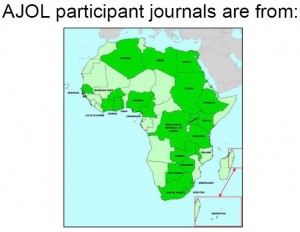
Figure 1a: Distribution of Journals in Africa (used with permission from Ms. Murray)
View Map of Africa in a larger map
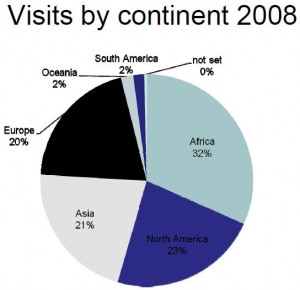
Figure 2: Visits by continent (used with permission from Ms. S. Murray)
(3) Comparison of old and new systems
After the overview and elaboration of the users and stakeholders of AJOL, Ms. Murray went into the details of the AJOL on OJS 2.2.2. She expressed the benefits of such a partnership with PKP led to better upgrading of the system. She found that more advanced versions could also be complied and were easier to upload which allowed for more capabilities in the platform that were not possible before. Figure 3 shows flowchart of the software and resources used ending with final product of the Open Journal Systems coded through the PHP scripting language using MySQL as the database management tool in the APACHE web browser run from the Linux operating system.
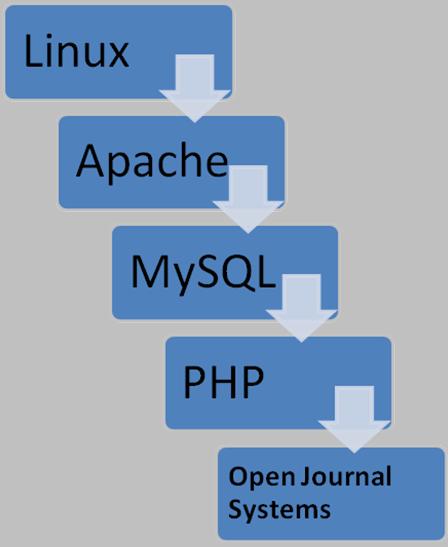
Figure 3: Software and Resources (created by Pam Gill)
A comparison of the new and old system is shown in Figure 4. The new approach is useful for all parties involved and is an excellent search tool with a new look and feel. Currently, as of July 2009, journals now manage their own AJOL pages in terms of the workflow management. In the future, Ms. Murray envisions that journals will be able to host their own versions of OJS on the PKP harvester which acts as a metadata aggregator. The newer versions will include a statistics package and offline plug-ins when connectivity is interrupted. The offline plug-in option will be crucial for users living in remote areas. Eventually, Ms. Murray envisions all journals being independent and managing their own pages.
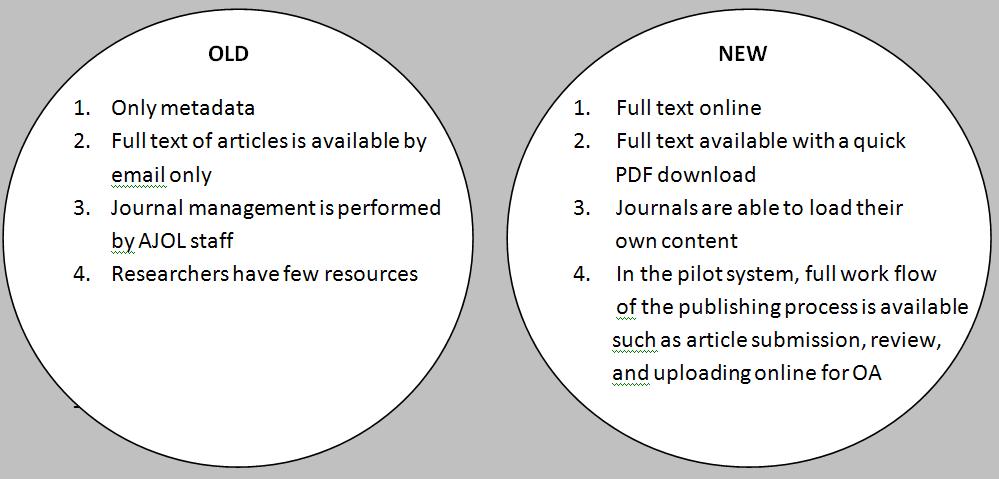
Figure 4: Comparison Chart of Old and New Systems (created by Pam Gill)
To conclude her presentation, Ms. Murray placed great emphasis on the need for the flow of global information from the North to the South (Evans and Reimer, 2009). She stressed the implementation of a new business plan that would allow journals to consider OA as a more viable possibility via AJOL/PKP. The full OJS functionality on AJOL has already made a huge difference as discussed earlier as open source software (OSS) has matured considerably. To summarize Ms. Murray ended her presentation one two key points to promote and continue the dissemination of literature in developing countries. First she brought forth the importance of carefully selecting the best tool that will take into account the needs of the users. Next, she advised to carefully align yourself with partners that you trust and who will support your initiatives for the right reasons. The following quote from Ms. Susan Murray herself summarizes these points:
“Relationships and communication are still the drivers of success, the technological tools are just the vehicle.”
– Susan Murray (2009)
This quote from Ms. Murray is used to illustrate that the technology can help propel the dissemination process in varying capacities. Technology depends on the specifications and limitations of the hardware and software. Yet, at the end of the day, relationships with others are the most important in terms of communicating, working collaboratively sharing ideas, which will ultimately lead to the success (or failure) of your goals and aspirations.
Questions from the audience asked at Ms. Murray’s session:
Question: Is AJOL published in other languages (referring to Figure 1 of African map from Susan’s PowerPoint slide)? Does AJOL have plans to bring more non-English journals to the portal?
Answer: Yes, we are hoping to introduce this to Francophone countries by starting the process of translating to French. So there will be an English/French option. We have a few journals published in Portuguese, Arabic. If we have a journal that is online (and space is NOT a problem) then we can publish in a local, indigenous and international language. Then at the same time research can be read by the local community and broadly by the rest of the world. This will increase readership and the journal will have met the needs to satisfy the best of both worlds.
Related Links
Conference attended by Susan Murray
Software/Sites
- African Journals Online
- OJS 2.2.2 Download
- PKP Open Archives Harvester: free metadata indexing system
References
Evans, J.A, & Reimer, J. (2009). Open Access and Global Participation in Science . Science. 323, 1025
Murray, S. (2009). Open journal systems (OJS) software as used by African journals online (AJOL). PKP Scholarly Publishing Conference 2009. Retrieved 2009-07-09, from http://pkp.sfu.ca/ocs/pkp/index.php/pkp2009/pkp2009/paper/view/216
July 11, 2009 1 Comment
Maximizing the Reach of a Graduate Research Journal Through Open Source Tools and Social Media: The Session Blog
Presenter: Rajendra Bose
July 10th, 2009 at 3:30 p.m.
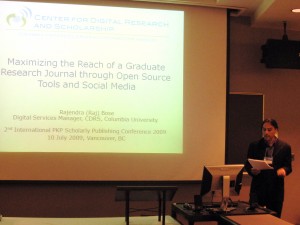
(used with permission from Raj Bose)
Background Info
Cultural Formations is an online journal (due to launch next month) that is open-access and peer-reviewed. The Center for Digital Research and Scholarship (CDRS) collaborated with Columbia University’s Teachers College to form Students for a Cultural Studies Initiative (SCSI). This project has grown to become more than just an online journal, using the concepts of Web 2.0 and Social Media as well as a research repository, Academic Commons.
As quoted on the Cultural Formations website, the journal-plus project has “…three integrated elements: an online journal of peer-reviewed articles, a blog for discussion of published articles and works in progress, and a wiki to serve as a “Wikipedia” of cultural studies and education.”
Session Overview
Graduate students at Columbia University and the Teachers College joined forces to form SCSI. Over the past year, they have worked hard to start a “journal-plus” – an online space that looks at cultural formations including youth culture, media, music, art, film and ethnicity, etc. Their goal is to not only publish research but to be accessible to the entire community, not just academic scholars. Along the way they were faced with significant challenges (examples include web design, technical problems with layout of the vastly different programs and challenges from having multiple partners with decision-making authority). They are however on schedule to launch their site next month. (Please stay tuned to this blog for the launch announcement!)
Services they hope to provide
- Publications – e.g. online books, journals
- Conferences
- Academic Commons
- Wikischolars
An example of what their website will look like:

(Used with permission from Raj Bose)
The goals of the Cultural Formations site are three-fold:
- authority of a journal
- immediacy of a blog
- what’s new and emerging in wiki format
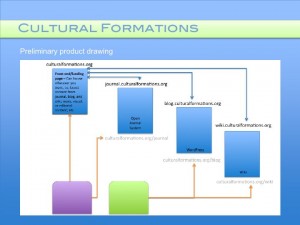
(Used with permission from Raj Bose)
The site is scheduled to launch in August 2009 at Culturalformations.columbia.edu (URL may change prior to launch).
Questions from the audience
1. Impressive. Will you open this up to the public as open source?
Yes, we are using all open access materials. The idea is to share it with the rest of the community, Users may have to connect with us to get a user profile as it may be too expensive to allow it open to all users at once. There likely will be a basic free level, and we may charge for some of the more advanced functions. We feel the site will have longevity with the article content/repository.
2. Is there a similar movement in other universities?
Yes, but the idea right now is to work with university presses and authors right here to get the right agreements.
3. Is there going to be any co-ordination with other groups?
Already there are 50-100 student journals with OJS [Open Journal System]. You especially want this system for longevity when a student group starts to fade out, this will help. The university hosting this site will help keep those groups up and running.
4. What about groups with other levels of education and how this may be used?
This idea is not a typical journal, but the idea to connect a blog and a wiki so that other members of community can join or help is amazing and very inclusive. Because of this, there will only be a light peer review. They partners want to keep this as open as possible.
Related Links
Center for Digital Research and Scholarship (CDRS)

Open Archives Initiative Object Reuse and Exchange (OAI-ORE)
July 10, 2009 Comments Off on Maximizing the Reach of a Graduate Research Journal Through Open Source Tools and Social Media: The Session Blog
Creating an Open Access Journal; A Medical Students’ Prospective: The Session Blog
Presenters: Steven Andrew Plato II and Andrew James Wyman (remotely), David Solomon in-house
July 10th, 2009 at 3:30 p.m.
Background info
Steve Plato and Andrew Wyman are third-year medical students from Michigan State University who saw a need in the literature for a dedicated place for medical students to publish their work and founded The Medical Student Research Journal (MSRJ) in 2007. They are due to publish the first issue this fall.
Session Overview
The session got off to a rough start with a few technical difficulties (due to new too-loud speakers in the meeting room at Simon Fraser University). The students gave the presentation from their editorial room in Michigan via Adobe Connect Pro. They use this to connect with the many geographically diverse authors/editors/faculty associated with their journal. The image, Powerpoint and voice are very clear. This is an exciting software tool for all distributed learning models.
The students went on to explain that they started the journal to fill a gap. Most students have extensively researched their chosen field of specialty throughout medical school, but often do not know how or where to publish their work. Whereas 60-100% (depending on specialty) of medical students matching to their first-choice residency stated they had extensive research in their field, the proportion of those that had published was as low as 35% for some specialties. MSRJ is peer-reviewed, authored and edited entirely by medical students which they hope will be the go to journal for medical students to publish that work.
This project was started at the Michigan State University but the creators hope to reach medical students throughout the US as well as internationally. THE MSRJ uses Open Journal Systems (OJS) and Creative Commons licencing to ensure communication and availability of publication to all medical students. This project is similar to a one started a few years earlier by the same institution (MSU) in a graduate biotechnology course (see session blog from this conference) however on a much quicker timeline, around 28 days!
OJS has been very helpful for the med students as it helps to facilitate their multi-location system, has low overhead and allows them rolling publication with minimal delays. They also like the management tools that help to guide novice editors (reminders/checklists) to make the process simple. OJS also tends to being in a larger readership.
Faculty
Faculty assure quality peer-review. Students are trained by faculty in critical appraisal, principles of scientific writing and academic integrity. They are also able to review a mock article and can compare their reviews to similar good and poor examples to learn to become a better reviewer. Faculty also provide guidance on sustainability and establish good practice in mentees (more hands-on and one-on-one time with people who know the literature the best). The students all go through an online training module, from the Annals of Emergency Medicine, prior to starting as well.
Usually one faculty will mentor 3-4 students per article. This helps less experienced reviewers in specific fields. They also provide feedback and guidance on where a review may be lacking. Students can then re-review and submit, then the editor decides to accept, accept with revisions or decline the article.
Sustainability plans?
Many other journals before this have struggled with longevity. MSRJ have instituted a student replacement policy (juniors that will take over when the current editors are done) and training sessions for editors which serve as quality control. In addition a letter from the Dean will be placed into the student file for encouragement to participate and to continue the job. Faculty are also rewarded by recognition in published material as well as a formal letter to their respective Departmental Chair. An annual report with statistics on publications is also planned for accountability
Finances?
The students plan for this journal to be a free or very low cost venture. All labour is by students or faculty. There is a minimal cost for the website host, however their major cost is copyediting, which they hope will be eliminated by using university resources. XML generation is also a marginal expense as is website development.
Benefits
The students feel the benefits are quite clear. They build experience in scientific writing and editing as well as get a head start on publications for their career. It is also strongly beneficial for those students doing research outside academic centres such as rural and distributed sites.
Since Open Journal System (OJS) has become a forerunner in educational resources, many other institutions have been able to start similar projects, with one just ready to launch this fall here at my home institution, UBC. The UBC Medical Journal will provide medical students with a forum to publish their research work that previously had no definitive place for publication.
Questions from the audience
1. I understand medical school is an intense experience. Do you have to sacrifice other parts of the educational experience to participate?
While it is true it is intense, but one thing about medical school is it does allow you to do things outside of school. Most students are involved in extracurricular activities already and 60-100% already involved in research. There will be some sacrifice, but usually that would be less time for research projects (i.e. one instead of two). The time intensity of the reviewer part of the job is not significant. Students only review one article at a time. There is a base here already, but it does take away time, hopefully that time is well spent.
2. Are the training materials you used publically available?
Yes they are online in the Annals of Emergency Medicine Journal. They have a great online flash based training process that we used.
3. Do you plan on only accepting articles from MSU or do you plan to open the journal up to other universities?
This journal will be open to med student/residents around the world once it is started. MSU is unique in their distributed plan in the states. Right now, you can submit from anywhere, but we hope to expand reviewers across the country.
Related links
The Medical Student Research Journal
Andrew@msrj.chm.msu.edu
Steven@msrj.chm.msu.edu
dsolomon@msu.edu

July 10, 2009 Comments Off on Creating an Open Access Journal; A Medical Students’ Prospective: The Session Blog


